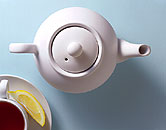
WEDNESDAY, Feb. 20 (HealthDay News) — Antioxidants are celebrated as “brain foods” and “super foods,” but a new study suggests that not all diets high in antioxidants reduce the risk of dementia and stroke.
The study involved more than 5,000 people in the Netherlands who were 55 years and older. Researchers determined each participant’s antioxidant score, based on questionnaires about the foods they typically ate, and kept track of whether they developed dementia or had a stroke over the next 14 years.
“We asked, ‘Is the [measure] of total antioxidant levels the important predictor for dementia and stroke, irrespective of what foods are contributing?'” said Elizabeth Devore, an instructor in medicine at Harvard Medical School in Boston and lead author of the study.
Although the study did not find lower rates of dementia and stroke among people with antioxidant-rich diets, similar research in other populations has come to different conclusions. For example, a study of older Italian adults found that higher antioxidant levels were linked to lower stroke risk.
The difference between the Dutch and Italian groups could lie in the types of antioxidants they eat, Devore said.
Almost 90 percent of the variability in antioxidant levels among the Dutch participants was due to coffee and tea consumption, whereas the antioxidants in the Italian cohort came largely from eating fruits and vegetables.
“There’s a lot of [studies] to suggest that higher fruit and vegetable intake is associated with lower risk of stroke,” Devore said. “It is possible that, though the Italian study did report diet antioxidant score, that is really being driven by those specific foods.”
“It is not about total antioxidant level, it is about specific antioxidant-rich foods,” Devore added.
The research in the Dutch population was published Feb. 20 in the online issue of the journal Neurology.
“It’s a little bit hard to interpret the finding that total antioxidant capacity of the diet does not have a role, because of the abundance of evidence showing that oxidative stress [on cells] has a role in these diseases,” said Gene Bowman, a nutritional epidemiologist at Oregon Health and Science University, in Portland.
However, “it may be that the antioxidants that they’re capturing aren’t the ones that are the big players,” Bowman said.
Still, the idea of looking at total antioxidant capacity instead of individual antioxidant-rich foods is a new and important approach, he said.
“We’ve already had large observational studies showing us that certain antioxidants are linked to less stroke and dementia risk, but when giving these antioxidants in clinical trials to reduce risk for less stroke and dementia, the results have been disappointing,” Bowman said.
The current study included almost 5,400 people who did not show signs of dementia and almost 5,300 people who had never had a stroke.
Participants answered questionnaires about how often and how much they ate 170 typical Dutch foods. The researchers looked up the antioxidant capacity of each food item, which had previously been determined by chemical analyses, and added up the capacity of all the food items to calculate each participant’s antioxidant score.
“There are thousands of antioxidants in the diet, and some of them may have more antioxidant power,” Devore explained. This calculation allowed the group to estimate the whole antioxidant measure, although it does not take into account how antioxidants in different food items could influence one another, she added.
“The typical Dutch diet tends to be a lot of meat, pork or beef, a lot of dairy, coffee and tea, and lower intakes of fruits and vegetables,” Devore said. The diet in this older population probably did not change much over the 14-year follow-up, she added.
Between 1990, when the researchers conducted the food surveys and collected the first health reports, and 2004, 599 of the participants developed dementia and 601 had a stroke. There was no difference between the groups that had high and low antioxidant capacity and the rates of these diseases.
Devore and her colleagues also failed to find a connection between total diet antioxidant power and brain sizes among the 462 participants who got an MRI test.
These findings suggest that it is time to go back to studying individual antioxidants, but more comprehensively, Devore said.
A connection between vitamin C and vitamin E and reduced risk of stroke and dementia, respectively, has been found in a number of studies, but there are probably other antioxidants such as flavonoids found in foods including onions, peas and berries that could be important, Devore said.
For his part, Bowman thinks there could still be a connection between antioxidant capacity in the Dutch group and dementia and stroke risk, but the researchers are not seeing it because they used food questionnaires to evaluate antioxidant levels.
“An alternative approach would be to look at dietary signatures in the blood,” Bowman said.
Measuring nutrient levels in the blood could not only give a direct indication of what is available to the brain, but it could help avoid the inaccuracies in what people say they eat and differences in how well individuals absorb what they eat, he added.
In a 2012 study, Bowman and his colleagues developed a test to measure the levels of a panel of nutrients in the blood and found a connection among elderly people between high levels of vitamins B, C, D, and E and improved cognitive function and larger brains.
Although this connection has to be studied more, Bowman is working to start a clinical trial to test whether increasing the level of vitamins C and E could indeed help protect the brain from diseases.
In the meantime, Bowman gives his patients the same advice: to cut out the junk, such as trans fats, and load up your diet with antioxidant-rich nutrients. He only recommends antioxidant supplements temporarily if someone has low blood levels.
More information
Find out more about antioxidants at the U.S. National Institutes of Health Office of Dietary Supplements.

